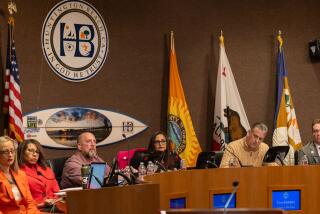Concern for Bird Life Sparks Investigations of Marsh Bulldozing
As Huntington Beach officials saw it, their mid-December cleanup was just part of park maintenance. Saying that an inlet of Talbert Lake harbored rats and was a breeding ground for thousands of mosquitoes, they bulldozed willow trees, cattails and bushes from three acres of marshland in the city’s central park.
But local Audubon Society members are outraged, claiming the city has destroyed an oasis for birds, one of the best bird-watching sites and one of the last freshwater marshes in Southern California.
Echoing the bird watchers’ concerns, this week three federal agencies and one state agency--the federal Environmental Protection Agency, the Army Corps of Engineers, the U.S. Fish and Wildlife Service and the state Department of Fish and Game--launched investigations into the city’s action.
In a letter of complaint to the other agencies, Nancy M. Kaufman, project leader of the U.S. Fish and Wildlife Service’s Laguna Niguel office, on Tuesday declared that the bulldozing appears to have proceeded without required federal and state permits, constituted unauthorized fill of a wetland and destroyed part of a “riparian habitat within the park that supports one of the largest and densest concentrations of passerine migrants (migrant songbirds) anywhere in Orange County, or for that matter, the Western United States.”
If it is determined that the city acted without permits, it could be forced to restore the habitat.
According to U.S. Fish and Wildlife Service biologists, more than 40 species of birds regularly bred within the marsh and more than 200 species have been sighted there in the last four years, including American lesser goldfinches, bushtits, northern orioles, warbling vireos, hermit warblers, cinnamon teal and ruddy ducks. In addition, a small songbird called the least Bell’s vireo, on both state and federal endangered species lists, was sighted in the park in the fall of 1985.
Riparian habitat--wildlife habitat adjacent to a river, pond or lake--is increasingly rare in Southern California, federal biologists said.
“Southern California has lost over 80% of riparian areas that were once existing,” Kaufman said. As their habitat has become limited, the species that used to live in those areas have been declining, too.
Loren Hays, an avid bird watcher and the Fish and Wildlife Service biologist who discovered the bulldozing, said many birds displaced by the parks’ cleanup effort probably will not be able to find another freshwater marsh to support them and probably will die.
But Daryl Smith, superintendent of parks, trees and landscaping for the City of Huntington Beach, argued that the bulldozing, performed at the request of county Vector Control officials, was done in a manner respectful of wildlife.
Although the bulldozers scraped “a jungle” of wild vegetation from marshy land at the Jack Green Nature Center, the contractor left some black willow trees and several stands of cattails untouched on the remaining black mounds of dirt that now form the banks of Talbert Lake. In a finishing touch to this $12,000 cleanup, the city will soon begin replanting some willows, Smith said.
“We did not destroy any wildlife that wasn’t replaceable or hurt the nesting,” he said. “We didn’t just go in with a meat-ax and cut the whole thing down. We’re trying to provide not just a bird sanctuary but a place where people can jog and camp.”
Agreed Huntington Beach Mayor Jack Kelly: “I have no feeling but that we did the right thing for the purpose and in the name of public safety through clearing out some . . . questionable wildlife.”
As evidence that the marsh at Huntington Central Park needed pruning, “hundreds and hundreds of rats were coming out of all that brush and debris” during the bulldozing, Smith said. “What I’m worried about, I don’t want to see some type of deal like bubonic plague.”
Smith added that he did not believe federal or state officials have any jurisdiction over a city park.
Fred Beams, assistant manager of the Orange County Vector Control District, agreed: “You can’t wait and consult with every agency that may have some jurisdiction on that when you have a high number of mosquitoes because then you have a human health risk. . . .”
However, federal officials maintain that under a 1972 amendment to the Clean Water Act, they do have jurisdiction over all wetlands, usually defined as swamps or marshes. “Every little stream, every little pond, everything that’s even moist” comes under the enforcement authority of the Corps of Engineers, said Glen Lucas, chief of the corps’ south coast section regulatory branch.
Robert Leidy, West Coast enforcement coordinator for the Environmental Protection Agency, said mosquito or rat problems should be susceptible to control with chemicals or traps in a way that would minimize damage to wetlands.
If the EPA determines that Huntington Beach needed a permit for its work and failed to get one, “we’ll probably seek some sort of restoration” of wetlands--requiring Huntington Beach to replant the high grasses and thick brush that the city’s contractor pulled out, Leidy said.
Officials from EPA, the Corps of Engineers, the Fish and Wildlife Service and Department of Fish and Game expect to meet with Huntington Beach officials in the next two or three weeks to discuss the city’s cleanup effort, federal officials said.
Touring the banks of Talbert Lake last week, Fish and Wildlife biologist Hays watched a dozen ducks preen their feathers. But these were “Easter ducks,” he said, non-wild ducks given to children as Easter presents and later taken to the lake. The many wild ducks that used to frequent the area--ruddy ducks, shovelers, green wing teal--were gone, he said.
“There would be, typically, a much greater variety of species here,” Hays said. “But there’s virtually nothing for them to eat now. . . . It seems they (Huntington Beach city officials) have declared war on vegetation.”
Both Hays and Richard E. Kust, president of the Sea and Sage Chapter of the National Audubon Society, said this wasn’t the first city cleanup. Last summer both had complained to Smith when city crews chopped down a 150-by-30-foot section of vegetation in the same area.
But “this is much worse. Compared with this, that was just a minor haircut, whereas this is a complete scalping,” Kust said.
Parks superintendent Smith didn’t agree. “I feel very strongly that what we’ve done is correct,” he said. “We take into consideration the health, safety and welfare of the community. We just don’t go in and rip, snort and remove.”
More to Read
Sign up for Essential California
The most important California stories and recommendations in your inbox every morning.
You may occasionally receive promotional content from the Los Angeles Times.










